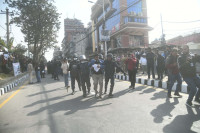Opinion
Southasia 2.0
The premise that regional integration can be achieved through the trappings of a nation-state must be dispensed with
Rishikesh Ram Bhandary
It is painfully obvious that Saarc has made little progress in regional integration. Intra-region trade, while increasing, remains tremendously low. The mobility of peoples and money is also limited, let alone the convergence of deeper values. On the flip side, the assumption of India as the hub and the rest as spokes is limiting and has held back much of the region’s potential. These models have proven inadequate, so there has been a call for something more transformational. This is where the term ‘Southasia’ comes in.
Bridging words
Thinkers, notably through the publication Himal Southasian, have used ‘Southasia’ as a term to excavate the region’s shared histories and renew sense and spirit by joining ‘South’ and ‘Asia’ together. The argument goes that the present-day post-partition nation-state of India has been portrayed as the inheritor of the ancient civilisations of this region. This civilisational sense has been further sanitised to fit India’s national mythmaking. Thinkers further argue that as two distinct words, South Asia reflects the impulse of outsiders to categorise the ‘Other’. Ergo, a more ‘internal’ term, Southasia.
Taking the term Southasia and its historical context together, we have at least two implications. First, the task of regional solidarity is more difficult when the regional has been reduced to the national. Since territorial India is not really civilisational India, it has hardened the shells that non-Indian nationalists retreat to when push comes to shove. For example, what is widely described as the paranoia and sensitivity of us Nepalis to seemingly trifling issues, like where the Buddha was born, is simply a reflection of how we have attempted to resist this narrative. Therefore, there is a need to recover a regional identity with a more expansive and politically acceptable term.
Second, recognising Southasia also means finally getting over the trauma of partitions. Sensitivities of small states next to big neighbours are easy to explain and almost universally observed. Sensitivity of a big state vis-à-vis its much smaller neighbours is harder to grasp. And, yet, we must. The trauma of colonial rule and partitions is not equally felt throughout the region but points us to how it may have a lingering effect.
National consolidation
Some have argued that one of the biggest constraints to India’s grand strategy is the unfinished task of national consolidation. Just a glance at the border regions from northeastern India to the enclaves along the Bangladeshi border to Jammu and Kashmir amply illustrates this. Can regional integration be achieved when national consolidation itself is lagging? It is quite possible that if Southasia as a whole were to become the common referent, unfinished tasks of national consolidation would have little meaning. Recognising Southasia also means asking India to take a necessary leap of faith. Having won an election on a nationalist plank, Indian Prime Minister Narendra Modi has the advantage and the political space for a level of magnanimity that other Indian prime ministers were not able to display.
Further, the perils of fixating on national borders were well foretold by the cosmopolitan Rabindranath Tagore, who asked us not to surrender our humanity to the idol of nationhood. Maybe, as the academic Rahul Rao argues, we are better off interpreting the current political borders as transitory, as the necessary consequence of a decolonisation process and international realities, and yet, as limited political constructs that must be overcome to achieve solidarity.
But, does this term have any material basis, if it needed one? While arguments calling for making this concept more grounded are certainly valid, the lack of seriousness on the need for regional aspirations at the elite level perhaps does not reflect realities on the ground. Take for example, those whose livelihoods depend so greatly on the region’s inter-connected natural resources. For them, Southasia is a daily affirmation. The political process has been slow and stubborn in recognising this.
Finding the soul
At the same time, if we are to realise Southasia, we also ultimately need to dispense with the premise that it can be achieved through the political trappings of a nation-state. After all, there is a fundamental irony in asking for greater regional solidarity with the tools and implements designed to resist it. However, this irony can be overcome. Hearts and minds should be won. Business and industry, art and culture, literature and music need to lead the way and politics will surely follow. Perhaps, Southasia might not really need an inter-governmental Saarc.
While terms like Southasia can be used for instrumental purposes to serve narrow particular ends, through their use they will stick enough to fundamentally alter who we are and how we think. When that happens, paraphrasing Jawaharlal Nehru, perhaps a moment will come when the soul of a region, long suppressed, finds utterance.
Bhandary is a doctoral candidate at the Fletcher School of Law and Diplomacy, Tufts University, the US




 13.12°C Kathmandu
13.12°C Kathmandu










